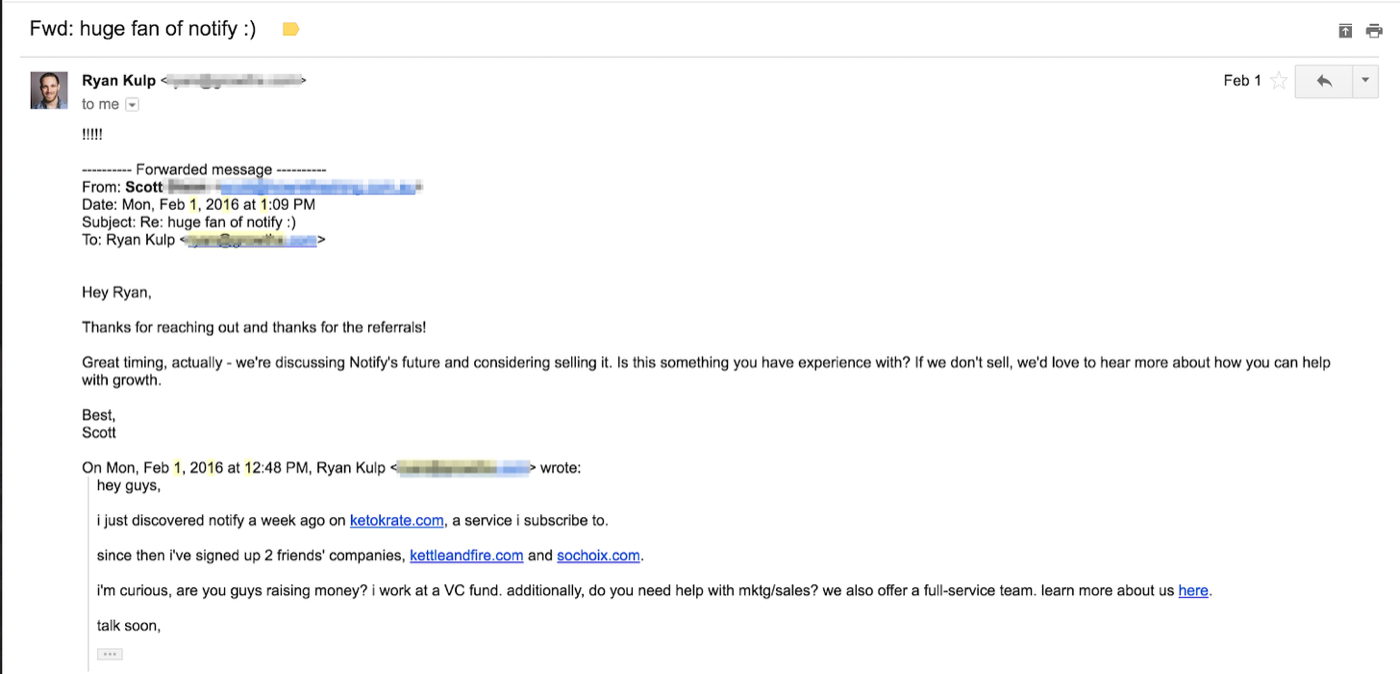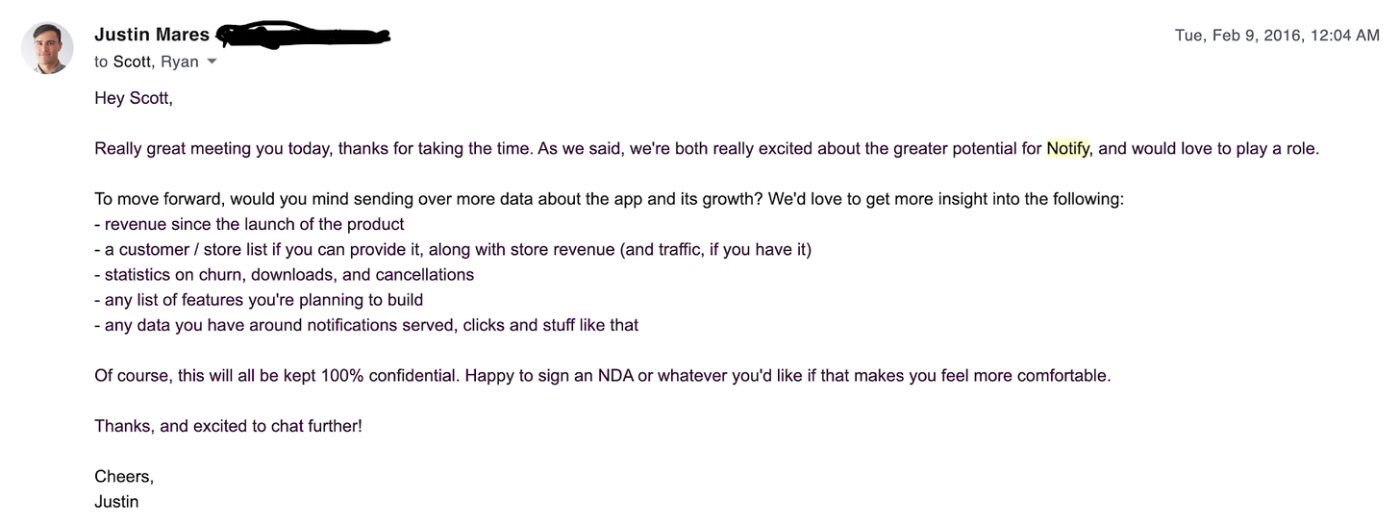
Sponsored By: Scrintal
This essay is brought to you by Scrintal, the game-changer for knowledge management. It's not just an app, it's a canvas of infinite ideas, offering bi-directional links for a seamless workflow. Perfect for research, project mapping, process formulation, planning, or studying - Scrintal lets you organize and connect all your thoughts in one place. Every subscribers get 10% off when you use the code EVERY10.
Editor’s note: We know that a lot of our readers are interested in acquiring and building businesses, so we’re re-publishing one of our most popular pieces on this topic from our archives. It’s part of a series on side businesses by author and founder Justin Mares.
Before starting Kettle & Fire—a direct-to-consumer bone broth company—I had a previous life in the SaaS world, running growth for a company that bought small SaaS apps and grew them. We sold the bundle of businesses to Rackspace for eight figures in early 2013.
When I left Rackspace after the acquisition and went out on my own, I wanted to replicate the model with which we’d seen so much success: I wanted to buy and grow my own SaaS business.
My partner Ryan and I were on the lookout for a business that fulfilled one of my side hustle criteria. A strong potential acquisition had to:
- Solve a problem someone is already aware of,
- In a niche where customers are already paying,
- Where the product does not require a lot of maintenance or hand-holding,
- And is profitable or has a no-brainer path to profitability.
In early 2016, we stumbled across Notify: a Shopify plugin that would pop up at the bottom of a website, displaying a purchase another customer had recently made.
As soon as I saw it in action, I installed it on Kettle & Fire and saw a 40% lift in conversion… and $1,400 in extra sales (this was 2016, so the company was a lot smaller then).
Whoa.
If it helped my site this much, how many others saw a similar sales lift? We had a strong hunch that we could buy Notify, add a few features, put some marketing behind it, and grow it.
On February 1, we fired off this email:
Buying an app, no matter how small, is a lot of work. I’d tried to purchase other software businesses in the past and understood how hard it was to come to an agreement. The process involves a good bit of legal spend and can fall apart at the drop of a hat—both lessons learned after spending $10,000 on legal fees for a failed acquisition 12 months prior.
We first wanted to see how serious Notify’s owner, Scott, was about selling. We emailed him and made plans for dinner one week after our first email exchange.
During dinner, Ryan and I expressed our admiration for what Scott had accomplished. We covered our backgrounds and shared the many ideas we had for the product that could take it to the next level. We learned a lot about the product. Within a day or two, we followed up with some early diligence questions:
After taking four days to review the numbers he sent over, we responded with a letter of intent (LOI), a legal but non-binding letter showing we were serious about buying the business. An LOI also serves to ensure that both parties are aligned on high-level terms, like what we’d pay, payment milestones, etc.
The key to negotiating
There are a few misconceptions about buying a small business.
It may feel like you’re listening to Uncle Warren Buffett espousing the benefits and strong returns that come from buying a railroad. Thanks, Warren, but how does this apply to me?
The reality is that you don’t need a lot (or any) money to buy many small businesses. In fact, you can actually buy some of them for $0 up front, if you negotiate properly and find a motivated seller. When revenue is less than $20,000 per month, many of the businesses you’re looking at aren’t businesses at all—they’re jobs. And if you find an owner (like we did) who wants to quit his job, you can make a deal happen. You’ll get what you want (a revenue-generating business), the seller gets what he wants (his time back and money for his efforts), and everybody wins.
While negotiating this acquisition, I kept in mind something one of my mentors shared when buying assets. Assuming you’re not in an intense competition for the company, it often pays to approach deals in this way: “My price, your terms OR your price, my terms.”
Let’s say we wanted to buy an app for $1 million and pay for it over 1-2 years with monthly cash payments. Our seller wanted to sell for $1.5 million.
In a scenario like this, we’d put in an offer of $1 million cash up front (his terms, our price) and see if that got it done. Alternatively, if the seller was firm on price but didn’t care as much about cash immediately, we’d offer $1.5 million paid out over 1-2 years in monthly cash payments (his price, our terms).
For the Notify deal, we ended up going with the latter option: the price the owner wanted for the company, on our terms.
Scott, Notify’s owner, wanted a high (but fair) price and a piece of the upside going forward. We landed on a structure that would reach his goals and allow us to buy the business for literally $0. Here’s how (note: numbers are not actuals):
- We agreed on an overall value of the business, call it $500,000.
- We discussed how much ownership Scott wanted to maintain in the entity going forward. Let’s say we landed at 20%. We then subtracted that ownership from the total purchase price and had to figure out how to come up with $400,000 to buy 80% of the business.
- Since he chose the price, we chose the terms. Our terms were that we’d buy the business via a series of monthly payments over the next 20 months. In our example $400,000 required purchase amount, we’d pay $20,000 per month to buy the business.
- Here’s the kicker: we structured the deal so that payments would begin 60 days after close. Because the business was already doing more than our monthly payments to the seller, as long as the business didn’t implode, we’d be able to buy the business with its own revenue. $0 out of our own pockets.
Once the price and terms were baked into the LOI (and the seller signed), we moved into deeper diligence—just 23 days after our first email to Scott.
We asked him to complete a questionnaire about Notify’s growth, revenue, tools used, and other information, as well as give us all the logins related to the business. Over the next two weeks, as we dug into the information he sent us, we worked with a lawyer to pull together an Asset Purchase Agreement (APA)—the document that would make the sale official.
Fast-forward to closing day, March 10, 2016. We received a signed APA and became owners of a business that was generating cash.
Several years later, Notify has become Fomo, a software business that does more than $1 million each year.
Though buying a small SaaS business is more competitive now, there are still a lot of opportunities to buy small assets and scale them on the side. If I were to run this strategy again, I’d focus on a few areas:
- Buying land and putting it on Hipcamp and other camping rental sites
- Buying up small apps in the Google Chrome or Mac app store
- Buying assets on rapidly growing platforms. Could you buy out a Fortnite skins developer? A creator on Roblox? A top theme developer on Webflow or Shopify? A tool on Figma?
- Buying small software businesses in industries tech doesn’t traditionally touch. In my world of consumer packaged goods and food, there are a ton of small software opportunities where a strong operator could buy an asset, tune it up, and do quite well.
Happy (small business) hunting!
Justin Mares is the founder of health food companies Kettle & Fire and Perfect Keto. This post originally appeared in his newsletter, The Next Brand.
The Only Subscription
You Need to
Stay at the
Edge of AI
The essential toolkit for those shaping the future
"This might be the best value you
can get from an AI subscription."
- Jay S.
Join 100,000+ leaders, builders, and innovators

Email address
Already have an account? Sign in
What is included in a subscription?
Daily insights from AI pioneers + early access to powerful AI tools


.png)












Comments
Don't have an account? Sign up!